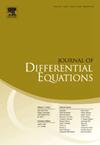On the global well-posedness of interface dynamics for gravity Stokes flow
IF 2.4
2区 数学
Q1 MATHEMATICS
引用次数: 0
Abstract
In this paper, we establish the global-in-time well-posedness for an arbitrary , , initial internal periodic wave for the free boundary gravity Stokes system in two dimensions. This classical well-posedness result is complemented by a weak solvability result in the case of or Lipschitz interfaces. In particular, we show new cancellations that prevent the so-called two-dimensional Stokes paradox, despite the polynomial growth of the Stokeslet in this horizontally periodic setting. The bounds obtained in this work are exponential in time, which are in strong agreement with the growth of the solutions obtained in [22]. Additionally, these new cancellations are used to establish global-in-time well-posedness for the Stokes-transport system with initial densities in for . Furthermore, we also propose and analyze several one-dimensional models that capture different aspects of the full internal wave problem for the gravity Stokes system, showing that all of these models exhibit finite-time singularities. This fact evidences the fine structure of the nonlinearity in the full system, which allows the free boundary problem to be globally well-posed, while simplified versions blow-up in finite time.
求助全文
约1分钟内获得全文
求助全文
来源期刊
CiteScore
4.40
自引率
8.30%
发文量
543
审稿时长
9 months
期刊介绍:
The Journal of Differential Equations is concerned with the theory and the application of differential equations. The articles published are addressed not only to mathematicians but also to those engineers, physicists, and other scientists for whom differential equations are valuable research tools.
Research Areas Include:
• Mathematical control theory
• Ordinary differential equations
• Partial differential equations
• Stochastic differential equations
• Topological dynamics
• Related topics

 求助内容:
求助内容: 应助结果提醒方式:
应助结果提醒方式:


